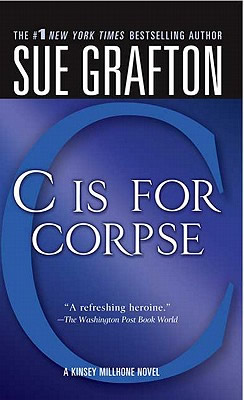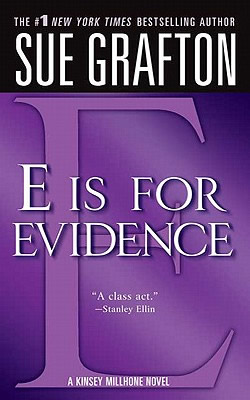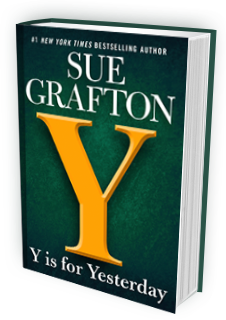 G is for Grafton:
G is for Grafton:
The World of Kinsey Millhone
by Natalie Hevener Kaufman
and Carol McGinnis Kay
Read the Table of Contents
Read the Preface
With the full cooperation of Sue Grafton, who provided unprecedented access to her working journals, "G" Is for Grafton is a must for those many fans who regularly write, e-mail, and Internet each other with such nagging queries as: "Just how old is Kinsey?" and such knotty conundrums as: "Why did Kinsey change guns—and when?" Along the way, readers will discover where Kinsey went to school, what she considers her finest moments, and how she trained for her job. Perhaps just as interesting are the insights the book offers into Grafton's own work habits (including how she's dealt with runaway plot lines and unruly characters) and her views on everything from justice and the moral order to the relationship of her own life to Kinsey's. Written with wit and vitality, this is a fan's delight. But it is also a tribute to the contribution Grafton has made to the detective novel and to mainstream American fiction.
Natalie Hevener Kaufman and Carol McGinnis Kay are on the faculty of the University of South Carolina at Columbia. Kaufman is a legal scholar and Kay specializes in Shakespeare, and both have run panels on women and detective fiction for the Popular Culture Association.
paperback | Henry Holt and Co. | 1997
ISBN10: 0805065075 | ISBN13: 9780805065077
Table of Contents
Preface 3
1: Kinsey's Biography 9
Early Childhood - Education - Career - Marriages - Lovers - Defense of Her History- Timeline for Kinsey Millhone
2: Kinsey's Personality 56
Independence - Sense of Humor - Anger - Compassion - Organization - Phobias - Kinsey Laughs At...
3: Kinsey's Daily Life 80
"In my own skin again": Kinsey's
Appearance
"Pulling Up the Drawbridge": Kinsey's Lifestyle
Apartments (includes floor plans) - Car and Driver - Food - Exercise -
Recreation - Kinsey Laughs At...
4: Kinsey's Personal Relationships 127
Major Friends appearing Throughout the
Series
---Henry Pitts (and His Siblings) - Rosie
Significant Friends Appearing in Several
Novels
---Lt. Con Dolan - Lonnie Kingman - Vera Lipton - Darcy Pascoe - Ida Ruth
- Mac Voorhies
Significant Friends Appearing in a Single
Novel
Bobby Callahan - Bibianna Diaz - Guy Malek - Cheney Phillips -
Danielle Rivers
Lovers and Ex-husbands
Charlie Scorsoni - Jonah Robb - Daniel Wade - Robert Dietz - Mickey
Magruder
Kinsey Laughs At...
5: The Scene of the Action 201
"White adobe and red tile roofs": Santa
Teresa and Environs(includes map of fictional Santa Teresa)
Landmarks
"Stuck a toothbrush and toothpaste in my purse and called itpacking":
Outside Santa Teresa
Southern California - Outside Southern California (includes map of
U.S.A. and Mexico)
Kinsey Laughs At...
6: Kinsey at Work 242
"Too rebellious, I guess": Training and
Job History
Formal Training: Police Academy - Formal Training: Santa Teresa Police
Department: Training and Use of Weapons - Life on the Police Force - After
the Police Department: Training with the Byrd-Shine Detective agency -
Self -employed as a Private Investigator - Unconventional Training
"I want quick results": How She Operates as a PrivateInvestigator
Methods of Investigation - Step One: Information Gathering - Step Two:
Recording the Information - Step Three: Understanding What She Has
Observed - Step Four: Solving the Murder - Step Five: Confrontation with
the Murderer
"CanI ask about the autopsy?": Kinsey's Relationship with the Police
Kinsey's Case Log
Kinsey Laughs At...
7: Social and Political Issues 294
Class - Family - Domestic Violence -
Child Abuse Outside the Family - Inadequacies in the Judicial System -
Politics - Vietnam War - Health Care - Corporate America - Sex Roles -
Prostitution - Ageism - Sexual Orientation
Kinsey Laughs At...
8: Is Justice Possible? 336
"I'm still a good person, aren't I?":
Kinsey's Personal Moral Code
Need for Answers and Order - Desire for Justice (includes chart of the
fates of murderers) - Distaste for Hypocrisy - Horror at Killing -
Importance of Honesty - Willingness to Lie - Acceptance of the Duality of
Human Nature
"Opening the door so all the ghosts could move on":Kinsey Considers Death
Kinsey Laughs At...
9: Grafton on Kinsey 368
10: Grafton's Writing Style 385
Tone and Descriptions- Figures of Speech- Images from Nature - Domestic Images - Problems with Writing a Series- Description of Action- Contradictory World - Themes- Plot Structure
11: Grafton's Place in the Development of the Detective Novel 417
Sue Grafton's Awards 445
Works by Sue Grafton 447
Bibliography 451
Index 455
Preface
"And this is where Renata jumped," Sue Grafton said, gesturing down at the rocks.
The four of us were leaning over the waist-high concrete wall lining the seaward side of the breakwater curving around the marina. We could hear the snap of the flags immediately behind us on the inner side of the walkway. Inside the marina were scores of boats, many wearing bright blue covers, their white masts bobbing up and down. Beyond them the town of Santa Barbara snuggled against the Santa Ynez mountains.
We all looked down at the dark, pockmarked rocks directly below us, waves churning and foaming around them. So this was the site of Renata Huff's suicide attempt and Kinsey's abortive efforts to save her in the final scene of "J" Is for Judgment. Unlike the tourist-brochure perfection of sunlight, blue sky, and blue ocean surrounding us, the rocks looked brutal and forbidding.
Steve Humphrey, Sue's husband, studied the rocks and waves for a moment and said, "I still say that anyone jumping onto those rocks would be killed immediately. There's not enough water here."
"Isn't this low tide?" one of us asked.
"The rocks are close to the surface even at high tide," replied Steve.
"Well, the rocks may be too close to the surface in Santa Barbara, but they're not in Santa Teresa, " Sue responded.
We all laughed with her and turned to continue our tour of the real world on which Sue Grafton has constructed Kinsey Millhone's fictional world. Having already covered the area of Kinsey's apartment and jogging path, Santa Barbara's Four Seasons Biltmore (which we know as the Edgewater Hotel) and wharf, we were ready to head for the downtown locations of Kinsey's two offices, the police station, the library, and the courthouse, before seeing the more outlying sections of Hope Ranch (Horton Ravine), Montecito (Montebello), and the Bird Refuge.
Kinsey Millhone's world is one many of us have been visiting for fifteen years through the pages of Grafton's popular alphabet detective series. By now, with Grafton halfway through the alphabet (N will be available in 1998), many readers have become thoroughly addicted to this appealing private detective who lives and works in Santa Teresa, California. We want to know everything we can about her.
Most readers will cite Kinsey as the major reason they rush to the library or bookstore for the latest Grafton. Kinsey's combination of toughness and vulnerability, bravery and intellectual keenness, compassion and aloofness, engages a wide range of readers of all ages and careers. Her ability to defeat the enemy in a terrifying final confrontation encourages us to think that someone might actually be able to clean up the mess we see all around us in the late twentieth century. At the same time, the personal struggles she goes through in order to do that clean-up reassure us that our own fears and phobias are both normal and manageable. If Kinsey is scared of getting an injection from a nurse yet is also capable of running after a murderer and tackling him to the ground, then maybe we can gather up our nerve to ask the boss for a raise, or hold our teenagers to a curfew, or perform whatever bit of daily living is a challenge for us. Things gone awry can be corrected, at least to some extent, and, equally important, they can be corrected by someone who has foibles much like our own.
Much of the appeal of these novels, then, lies in the dual appeal of escape from our daily lives and of reassurance that we can cope with our daily lives. While most of us don't chase scam artists into Mexico or become the target of a contract killer, we do know the fears of being the next person to be downsized at the office, or being mugged on downtown streets, or finding drug paraphernalia in our child's room. Grafton's novels allow us to confront those fears by fictionalizing and exaggerating the bogeyman into the worst possible situation—murder—and offering Kinsey Millhone as the knight who slays the dragon for us. We get the thrill of the big scare, but all in the safety of our comfortable chair (or wherever we like to read), plus we have the reassurance that the dragon can be slain—and by someone not all that different from us.
The intriguing world of Kinsey Millhone, a dragon-slayer who is frightened by dogs, is our focus throughout this book. We look closely at the details of Kinsey's life, work, and thoughts, the patterns they form, and the insights they may suggest about the reasons for Grafton's place among the most popular and influential writers of detective fiction in the twentieth century. We show those details through several lenses that are unique to this book: maps, floor plans, photographs, a time line of Kinsey's biography, case logs, and charts of the murderers' punishments, as well as description and analysis. Sometimes we speak and sometimes Grafton speaks, but Kinsey's is the voice heard most often.
To make this investigation, our primary resources have been the thirteen novels and Sue Grafton herself. She could not have been more cooperative and gracious in assisting us in our scrutiny of Kinsey and her world. In addition to showing us Kinsey's Santa Barbara/Santa Teresa, she helped make the maps in Chapter Five as accurate as possible. Likewise, she gave invaluable tips for the accuracy of the floor plans of Kinsey's two apartments in Chapter Three. And most important, she gave us hours of interviews about Kinsey, her own life and work, and herself in relation to Kinsey. We are delighted to be able to quote liberally from these interviews in the book, especially in Chapter Nine, where Grafton talks about Kinsey. Unless we note otherwise, all quotations from Grafton are from our interviews at her Kentucky residence in October 1996 and at her primary residence in Santa Barbara in February 1997.
Sue has also given us access to the journals she keeps as she writes the novels. The journal is, in her words, "a daily log of work in progress," which notes, among other things, when and where she gets stuck with a problem—of plot or character or tone—and how she chooses names and locales. "The journal functions as a playground for the mind, a haven where the imagination can cavort at will." These working documents make fascinating reading for anyone interested in Grafton, Kinsey, or the process of writing fiction.
We also drew on the eight Kinsey short stories published in several venues and collected by Steve Humphrey as a gift for Sue in a limited edition, Kinsey and Me. Because the edition was limited to only 350 copies, many readers may not know it. We have quoted extensively from it because this particular publication is highly personal: it also contains eight stories about her relationship with her mother written shortly after her mother's death. Sue's introductions to all the stories are candid revelations about her own life and her approach to her work. These introductions were an invaluable resource for us.
We should mention that our final resource was the expected one of reviews, critical articles, interviews, and book chapters on Grafton or Kinsey. The bibliography makes a distinction between works we've cited and related works that we thought might be of general interest for readers. A complete listing of Grafton's publications and awards to date is also included in the bibliography.
Each chapter of the book explores some aspect of Kinsey's life or character, beginning with the specifics of her biography, her daily life, her friends, her favorite places, and her work, and moving toward more abstract topics, such as her awareness of contemporary social issues, her ideas about death, and her sense of morality and justice. Each chapter draws on scenes from all the novels through "M" Is for Malice. Each chapter is a self-contained unit and may be read by itself. At the same time, the book forms a totality, moving from Kinsey as a person to Grafton as a person, and concluding with Grafton's own views on Kinsey, an analysis of Grafton's writing style, and commentary on her place of leadership in reshaping the genre of detective fiction.
Though the book is an organic whole, readers may want to use it for specific questions from time to time. In order to make this easier, the table of contents is detailed enough to allow a reader who, for example, wants to know how Kinsey found Henry Pitts and her apartment (or when her apartment was bombed and rebuilt, or exactly what the two versions look like) to find answers in Chapter Three: Kinsey's Daily Life, under "Apartments." The reader who wants to know exactly how she met Jonah Robb, how their affair developed and dwindled, and what Kinsey thinks of him by the time of "M" Is for Malice will find the answers in Chapter Four: Kinsey's Personal Relationships, under "Lovers and Ex-husbands." Want to know Rosie's last name? Check under "Major Friends" in Chapter Four, where you will find out why you'll never know her full name. Want to know why Kinsey once claimed Lt. Dolan was her boyfriend? Look in the same chapter for the section on Dolan. Would you like to know who taught Kinsey to put her notes on index cards? Look in Chapter Six: Kinsey at Work under "Training and Job History."
Those of us who read detective fiction love the pleasure of details and we love seeing the pattern behind the details. The authors of this book hope this investigation of Kinsey and her world will bring her many friends both the pleasure of recognizing some familiar details and patterns and an occasional frisson of insight into the unfamiliar.
Kinsey always likes to start a case by looking quickly at the overall picture and then going back to fill in gaps and make connections as she learns more and more about the various pieces of the puzzle. Following her lead, let's begin with a look at Kinsey's biography.
Copyright ©1997 Natalie Hevener Kaufman and Carol McGinnis Kay


 A is for Alibi
A is for Alibi B is for Burglar
B is for Burglar C is for Corpse
C is for Corpse D is for Deadbeat
D is for Deadbeat E is for Evidence
E is for Evidence F is for Fugitive
F is for Fugitive G is for Gumshoe
G is for Gumshoe H is for Homicide
H is for Homicide I is for Innocent
I is for Innocent J is for Judgment
J is for Judgment K is for Killer
K is for Killer L is for Lawless
L is for Lawless M is for Malice
M is for Malice N is for Noose
N is for Noose O is for Outlaw
O is for Outlaw P is for Peril
P is for Peril Q is for Quarry
Q is for Quarry R is for Ricochet
R is for Ricochet S is for Silence
S is for Silence T is for Trespass
T is for Trespass U is for Undertow
U is for Undertow V is for Vengeance
V is for Vengeance W is for Wasted
W is for Wasted X
X Y is for Yesterday
Y is for Yesterday




